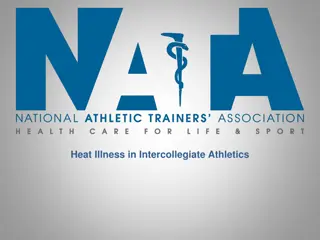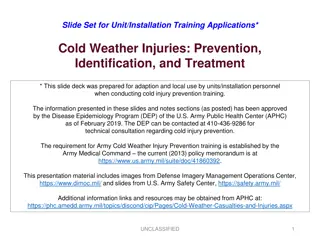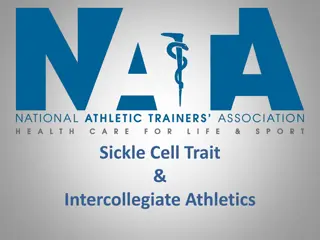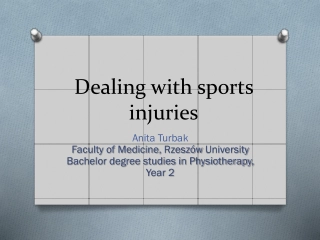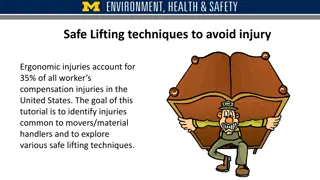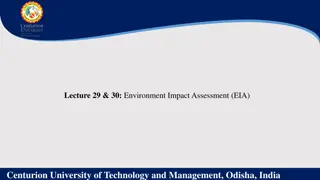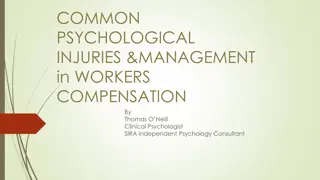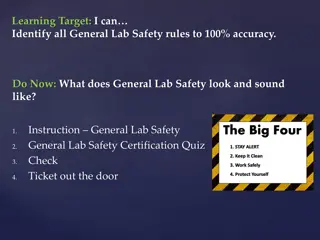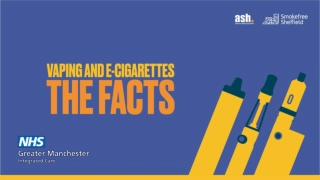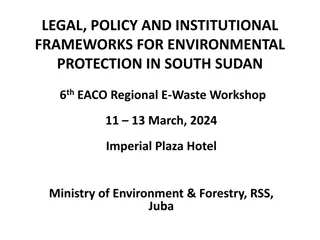Environmental Cold Injuries in Intercollegiate Athletics
Learn about environmental cold injuries in intercollegiate athletics, including hypothermia, frostbite, and chilblains. Understand the recognition signs and proper treatment methods to address these conditions promptly.
Download Presentation
Please find below an Image/Link to download the presentation.
The content on the website is provided AS IS for your information and personal use only. It may not be sold, licensed, or shared on other websites without obtaining consent from the author. Download presentation by click this link. If you encounter any issues during the download, it is possible that the publisher has removed the file from their server.
Presentation Transcript
Environmental Cold Injuries in Intercollegiate Athletics
Cold Injuries Cold injuries are classified into 3 categories: decreased core temperature (hypothermia), freezing injuries of the extremities, and nonfreezing injuries of the extremities
Hypothermia Hypothermia is classified as mild, moderate, or severe, depending upon measured core temperature Mild hypothermia is a core temperature of 95.6F (35.6C) to 98.66F (37.6C) Moderate hypothermia is a core temperature of 90.6F (32.6C) to 94.6F (34.6C) Severe hypothermia is a core temperature below 90.6F (32.6C) Recognition S/S: Vigorous shivering, increased blood pressure, rectal temperature less than 98.66F (37.6C) but greater than 95.6F(35.6C), fine motor skill impairment, lethargy, apathy, and mild amnesia Treatment Remove wet or damp clothing; insulating the athlete with warm, dry clothing or blankets (including covering the head); and moving the athlete to a warm environment with shelter from the wind and rain Heat/rewarm only to the trunk and other areas of heat transfer, including the axilla, chest wall, and groin Avoid applying friction massage to tissues, as this may increase damage if frostbite is present
Frostbite (Superficial) Frostbite is actual freezing of body tissues It is a localized response to a cold, dry environment, yet moisture from sweating may exacerbate frostbite due to increased tissue cooling Recognition S/S: Edema, redness or mottled gray skin appearance, stiffness, and transient tingling or burning. Rule out hypothermia by measuring core temperature Treatment To rewarm, the affected tissue should be immersed in a warm (98.6F 104.6F [37.6C 40.6C]) water bath Remove any constrictive clothing and submerge the entire affected area for 15 to 30 minutes keeping the water gently circulated Thawing is complete when the tissue is pliable, and color and sensation have returned Rewarming can result in significant pain, so a physician may prescribe appropriate analgesic medication Do not use dry heat or steam to rewarm affected tissue
Frostbite (Deep) Recognition S/S: edema, mottled or gray skin appearance, tissue that feels hard and does not rebound, vesicles, and numbness or anesthesia Rule out hypothermia by measuring core temperature Treatment Rewarming can occur at room temperature or by placing the affected tissue against another person s warm skin Rewarming should be performed slowly, and water temperatures greater than 98.6F to 104.6F(37.6C 40.6C) should be avoided Avoid applying friction massage to tissues and leave any vesicles (fluid- filled blisters) intact If rewarming is not undertaken, protect the affected area from additional damage and further tissue temperature decreases and consult with a physician or transport to a medical facility
Chilblain Chilblain, also known as pernio, is an injury associated with extended exposure (1 5 hours) to cold, wet conditions Chilblain is an exaggerated or uncharacteristic inflammatory response to cold exposure Recognition S/S: exposure to cold, wet conditions for more than 60 minutes at temperatures less than 50.6F (16.6C) and the presence of small erythematous papules, with edema, tenderness, itching, and pain Upon rewarming, the skin may exhibit inflammation, redness, swelling, itching, or burning and increased temperature Treatment Remove wet or constrictive clothing, wash and dry the area gently, elevate the area, and cover with warm, loose, dry clothing or blankets Do not disturb blisters, apply friction massage, apply creams or lotions, use high levels of heat, or allow weight bearing on the affected area During treatment, continually monitor the affected area for return of circulation and sensation
General Considerations of Environmental Cold Injuries Environmental cold injuries (frostbite, chilblains, and hypothermia) should not be the only area of concern when considering scheduling athletics in the cold All injuries can occur at an increased rate due to exercising at low environmental temperatures and can also impair how the body responds to mental and physical tasks Prolonged exposure to the cold environment most often leads to cold extremities Studies have concluded these cold extremities quickly lose sensation and proprioception once the tissue temperature starts to lower which negates and impairs the gait and balance control of the body (i.e. individuals lose track of their spatial awareness for their body) which may increase the risk of injury
Monitoring Institutions should have a written policy regarding the suspension or cancellation of outdoor practices/competitions per NCAA, NAIA and NATA Recommendations Monitoring of student-athletes safety should be continuous during events Athletic trainers, coaches, administrators, and other athletic personnel should be educated annually on the cold weather policy Environmental monitoring should occur any time it is cold outside (i.e. <41oF) Monitoring of wind chill should occur every 30 minutes beginning at least 60 minutes prior to the scheduled event
References National Athletic Trainers Association Position Statement: Environmental Cold Injuries (2008) https://www.nata.org/sites/default/files/enviro nmental_cold_injuries.pdf NAIA Championship Events Cold Weather Medical Policy



